

From Stanford Online's "How To Learn Math for Teachers and Parents": Number Talks. Teaching English without Teaching English. Students need to lead the classroom, not teachers. After watching this, your brain will not be the same. The One Thing All Great Teachers Do. Belief in Learning Styles Myth May Be Detrimental. WASHINGTON — Many people, including educators, believe learning styles are set at birth and predict both academic and career success even though there is no scientific evidence to support this common myth, according to new research published by the American Psychological Association.
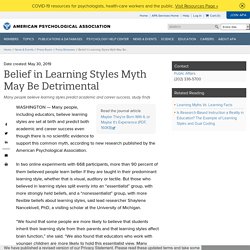
In two online experiments with 668 participants, more than 90 percent of them believed people learn better if they are taught in their predominant learning style, whether that is visual, auditory or tactile. But those who believed in learning styles split evenly into an “essentialist” group, with more strongly held beliefs, and a “nonessentialist” group, with more flexible beliefs about learning styles, said lead researcher Shaylene Nancekivell, PhD, a visiting scholar at the University of Michigan. Mathematics proficiencies. Moodle. Moodle. Exam and assignment resources. Skwirk. Exploring the Gestalt Principles of Design. Listen to the audio version of this article Negative space has long been a staple of good design.

Leaving white space around elements of a design is the first thing that usually comes to mind. But then there are designs that use that white space to infer an element that isn’t actually there (the arrow hidden between the E and X in the FedEx logo immediately comes to mind as an example). The Gestalt of Slides. The Laws of Figure/Ground, Prägnanz, Closure, and Common Fate - Gestalt Principles (3) We’re now going to take a look at some more Gestalt principles, building on what we’ve learned in the first two articles.
This third piece is particularly useful because having a good grasp of Figure/Ground, Prägnanz, Closure, and Common Fate will enhance your ability to design with more thoughtfulness, confident that you’re making the best use of some basic human tendencies to access your design and its impact. “The eye tends to build a relationship between elements, it fills in the gaps, and identifies hidden motion in the design.” Figure/Ground, Prägnanz, Closure, and Common Fate are Gestalt Principles that help the eye build these relationships: The Figure/Ground law examines how the eye can separate shapes in a design from the background of that design. First Steps Mathematics - Steps Resources.
Teaching resources. Education resources for schools teachers and students - ABC Education. Problem loading page. # Differentiating Instruction: It’s Not as Hard as You Think. Curtin University Library. Principles and practice. LingReps CER site300516. Scaffolding language, scaffolding learning : teaching English language learners in the mainstream classroom / Pauline Gibbons. Practical Literacy: The Early and Primary Years - Can it be as simple as reading a bilingual book? (Humanities & Social Sciences Collection) - Informit. Abstract: The 2016 year had started.

I was getting to know my class at Parramatta East Public School, a Year 1 and Year 2 composite class of students of many different linguistic and cultural backgrounds. The class consisted of 26 students, with 24 who spoke (or had parents who spoke) a language other than English. Staff Profile - The University of Sydney. Strategic reading action. High-frequency words. Composite language classes. Dictogloss for EAL/D students. Project 40 Video Essays. PETAA PAPER 196 — The critical conversation about text: Joint construction. In addition to understanding the features of targeted texts, questioning techniques can also assist in language development.
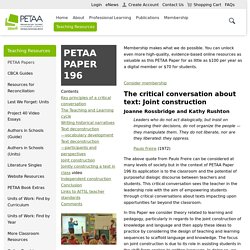
As explained by Dufficy (2005), a shift from the common ‘Initiation, Response, Feedback’ patterns to the use of a more conversational style and open questions can result in more expanded utterances which is a shift along the mode continuum towards more ‘written-like language in the oral mode’. Such questioning strategies can result in what is commonly referred to as substantive communication.
Support for the learner Successful learners need to take risks, play with language and develop a metalanguage to discuss what works and why. Teachers need to both engage and support students in the classroom to motivate them. PETAA Paper 188 — Literacy as behaviour, process, and social activity. From reading to literacy So where there is now an area named as ‘literacy’ in 1972 there was reading and English.
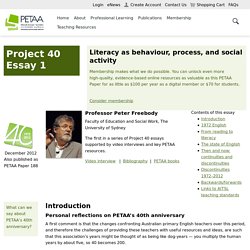
PETAA PAPER 183 — Teaching EAL/D learners in Australian classrooms. It is quite possible to read aloud fluently in a new language with minimal comprehension: the problem for many EAL/D learners is not that they cannot decode or read the words on the page, but that they cannot comprehend them.
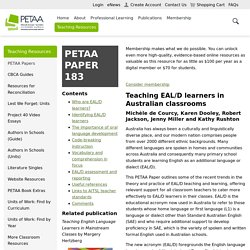
Vocabulary knowledge and comprehension are crucial in developing the ability to read meaningfully and to learn through reading, and research shows that there is a strong reciprocal relationship between the two. That is, vocabulary development is both an outcome of comprehension and a precursor to it, with word meanings making up as much as 70–80% of what learners understand from text. PETAA PAPER 213 — My language is in my heart and my head. Many children do not recognise the ‘repertoires of linguistic practice’ (Gutiérrez & Rogoff, 2003) that they bring to school, and they often internalise deficit views of their own skills.
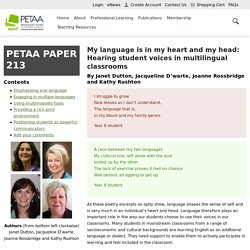
Creating opportunities for students to reveal what they know and can do values the student voice and supports the move from spoken to written language. The Black Dog Institute LMS. Learning.21stCentury.Snapshot - Home. ARTS:LIVE. Measure Wind Speed with Your Own Wind Meter. Key concepts Atmosphere Environment Speed Weather Wind Introduction Have you ever wondered how wind is made?

Wind is caused by a difference in air pressure. Air travels from areas of higher pressure to places where there is less pressure. And just as air flows out of the high-pressure inside an inflated balloon if the opening is not tied, air in the atmosphere will move to a lower pressure area, creating wind. Visuwords. Puzzlemaker: Game Based Learning. Writing skills and resources. Essays, case studies, lab reports and literature reviews are all part of studying at uni.

Luckily for you, there are plenty of opportunities to improve your writing skills. It's important to improve your writing skills regardless of your course. Whether you're writing business reports, lab reports, critical essays or literature reviews, most assignments involve writing in one form or another. More downloads - Phil Race. Please note that all downloads on my website are free.

If anyone tries to charge you for them, don’t pay, but let me know by emailing me (email address under the photo on all pages). This page contains the further download materials which I normally leave on the site permanently, and update from time to time. Please go to the Home page (containing new posts), and ‘archive of older posts’ for individual materials from particular events at individual universities or colleges, which I normally leave up only for a limited time. About downloading my materialsIt’s interesting that many more people seem to download my slides from workshops, and handout materials, than were actually at the relevant sessions I ran. Academic skills improvement for students. UniEnglish, Curtin University of Technology. Technologies for Teaching - Home. Schools and Curriculum - Home. Emergent Teacher Professionalism - Home. Five Predictors of Early Literacy.
First Steps Mathematics - Steps Resources. Oxford Owl from Oxford University Press. Welcome to our free eBooks collection, developed for children aged 3 - 11 years old. Help your young child learn to read with The Oxford Reading Tree (featuring our much-loved Biff, Chip and Kipper characters), watch your child develop their love of reading with Project X, or simply browse our range of eBooks for inspiration. All our free eBooks are tablet-friendly. Just register or log in above to start reading. If you'd like to learn more about how to support your child's reading, visit our 'Oxford Reading Tree levels' and 'Phonics made easy' pages. Browse the library sign up log in. First Steps Literacy - Steps Resources. Australian: How to Write the English Alphabet - Vic Modern Cursive Font. Words Their Way - Developmental Spelling Stages.
5 Stages of Spelling Development. The Grammar Dance. How to use apostrophes. Teachers TV: Punctuation - Commas. Verb Groups. What is a Genre or a Writing Style. Improving Reading Comprehension - Smrt Live Class with Shaun #8. Teacher Resources - Reading Horizons. Education Video Library. First Steps - Writing. What is a Genre or a Writing Style. Strategy for Teaching Students with Processing Disorders How to Read. 3 Strategies to use with Young and/or Struggling Readers. Reading Strategies. Teachers TV- Daily Routines. Place Value Chart. 1st Grade, 2nd Grade, 3rd Grade. Simple Patterns: Foundation Level.
My AITSL login. Principals Australia Institute. Home. ACARA. QAMT – Queensland Association of Mathematics Teachers. Welcome - Mathematical Association of NSW Inc. 12 Must Watch TED Talks for Teachers. Teaching Primary School. Early Childhood Learning. 6 Elements Of Play: The Spectrum Of A Relaxed Mind - TeachThought.
Free Stock Photos & Images - Royalty-Free & CC0 Public Domain Images by Dreamstime. John Dahlsen Environmental and Recycled Art - Media. 2 Compelling Reasons for Using the Studio Habits of Mind in Your Art Room. Magazine / 2 Compelling Reasons for Using the Studio Habits of Mind in Your Art Room Over a decade ago, researchers with Harvard’s Project Zero identified The Studio Habits of Mind. Through research, Lois Hetland and her team classified and named eight Studio Habits which include: Develop Craft, Engage & Persist, Envision, Express, Observe, Reflect, Stretch & Explore and Understand Art Worlds. Since then, the eight Habits have been a continuous force in reshaping how progressive art education is organized and administered.
As you can see, these are not novel ideas in art ed. They are, in fact, the basis of best practices in the art room. Land Art for Kids. Richard Shilling - Land Art. Richard Shilling on Land Art for Kids. How to Teach Drawing to Children. This essay was inspired by an Australian mother whose son, age eight, was feeling discouraged and wanted help in learning to draw better. How to Teach Art if You're Not 'Arty' Further Learning - Stages of Artistic Development. Crayon Etching. Levels of Questions in Bloom's Taxonomy: Teaching Methodoly Advice (Grades K-12) Challenge your students with all levels of questions as defined by Bloom's Taxonomy. They will be doing higher-level thinking and you will have a more interesting classroom! Chapter 4: Misconceptions as Barriers to Understanding Science. Disdain, they are often preferred by the learner because they seem more reasonable and perhaps are more useful for the learner's purpose (Mayer, 1987).
CAMPAGNES TUNIQUES. Teachervision. Australian Aboriginal Art. Google Image Result for. View more. A Guide To Traditional Japanese Art Forms.